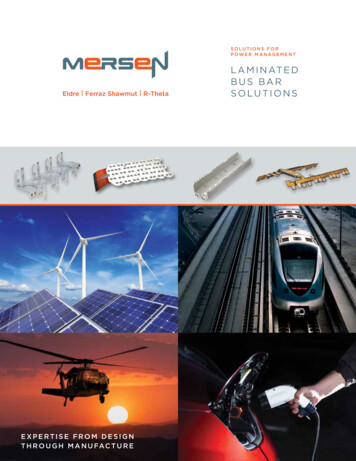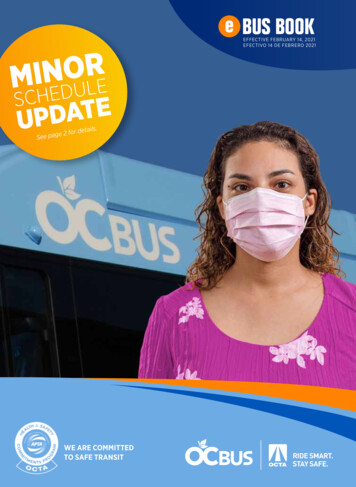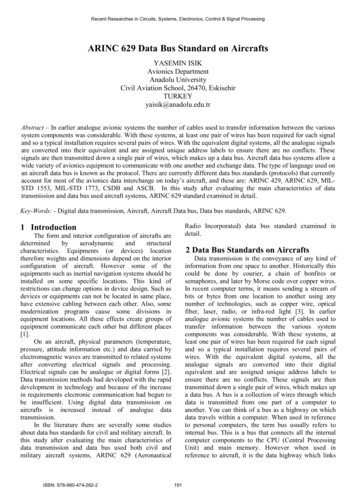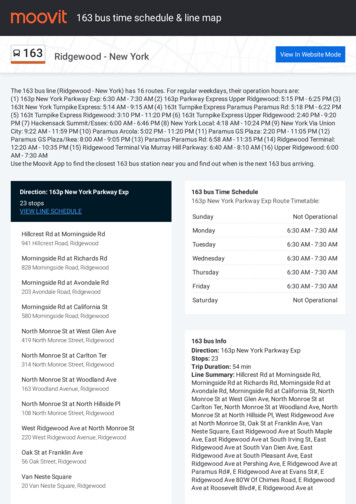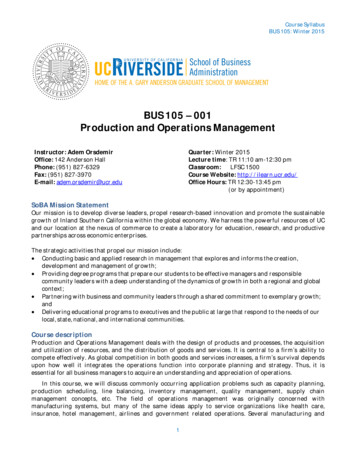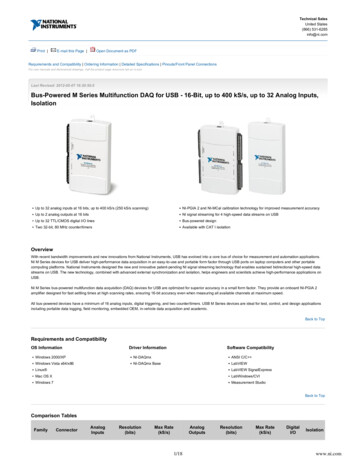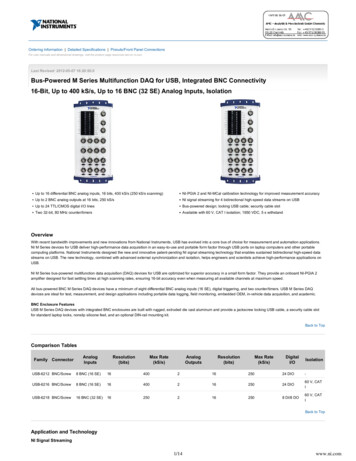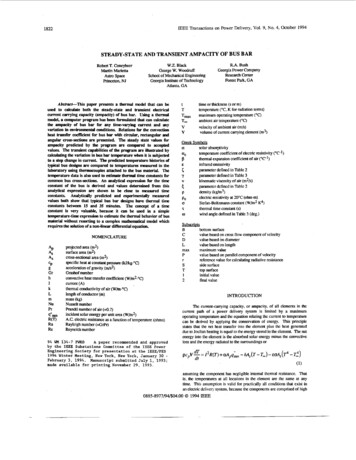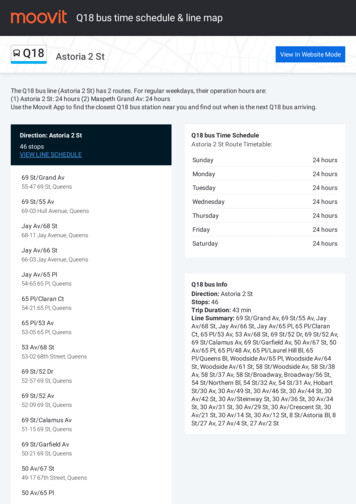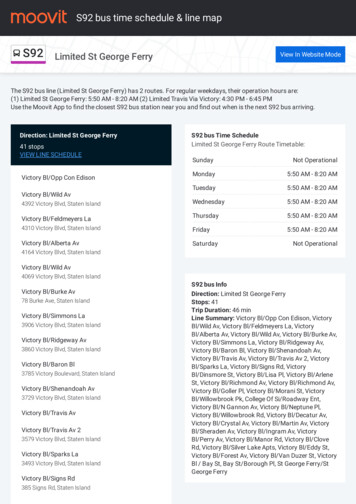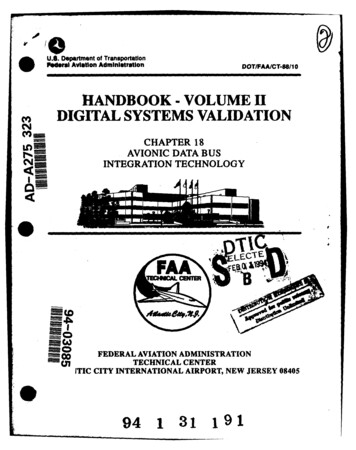
Transcription
.U.S. Department of TransportationAviation AdministrationPFe 1rsDOT/FAA/CT-88/10HANDBOOK- VOLUME HDIGITAL SYSTEMS VALIDATIONCHAPTER 18AVIONIC DATA BUSINTEGRATION TECHNOLOGY-tw,.C JCETICFEDERALAVIATION ADMINISTRATIONTECHNICAL CENTER[TIC CITY INTERNATIONAL AIRPORT, NEW JERSEY 08405941 31191
44BestAvaillableCOPY
NOTICEThis document is disseminated under the sponsorshipof the U. S. Department of Transportatii in the interestof Information exchange.The United States Governmentassumes no liability for the contents or use thereof.The United States Government does not endorse productsor manufacturers.Trade or manufacturers' names appearherein solely because they are considered essential to theobjective of this report.
Technical Report Documentaion Pegs1.FpoleNo.2. Government Accession NMe3. Recipient's Coteoeg No.IoTMIAAfCT-88/104. Title end Subtitle3. Report DoleHandbook - Volume IIDigital Systems ValidationChapter 186.Avionic Data Bus Integration TechnologyI.PerforminD. 2Ivell, L. Harrison, J.November 1993Hensyl, and N. VanSuetendaelPerformin Ogenet.tu,, CodeOrgonization Rep.o, No.DOTIFAAICT-88/10-9. Perfa-,ing Organisotion Namoe'nd Address10. Work Unit No. (TRAIS)Computer Resource Hanagement, Inc.200 Scarborough Drive, Suite 10811. Contract or Grant No.Pleasantville,V4'DTFA03-86-C-00042New Jersey 08232'3.Typo of Report and Period Covered12. Sponsoring Agency Name end AddressTutorialHandbook Chapter 18U.S. Department of Transpo-tationFederal Aviation AdministrationTechnical Center14. Sponsoring Agency CodeAtlantic City International Airport, NJ 08405ACD-230IS. Supplementary NotesPete Saracen , FAA Technical Center, Program Manager, (609) 485-5577(Note: This Tutorial is a condensed version of FAA Technical Center Final ReportDOT/FAA/CT-91/19)16. AbstroctAs multiple digital avionic systems were introduced into aircraft, there arosea need for digital coammunications between systems. In the early 1970's, manydifferent digital data bus designs were used to provide this communication.Because these digital systems proved to be reliable and cost effective, theirpopularity increased.Proliferation led to standardization, particularly inthe air transport category of aircraft, which allowed communications betweenline replaceable units (LRUs) to become more complex. The LRUs began to relymore heavily on each other to reduce the amount of equipment required.Sensordata and systems data could be shared among multiple systems, rather than eachsystem requiring its own private source.Integrated digital avionics are increasingly being used to implement essentialand critical functions that cannot be sufficiently reproduced by conventionalmeans. The safety of such aircraft is highly dependent upon the computersoftware, hardware, and data buses connecting the systems.The newestconcerns relate to the problems that are unique to highly integrated systems.There is no standard with which to assess the possible impact of these busbased systems on aircraft safety. These and other advanced avionic systemswill result in specific safety assessment problems when the appropriate datapackages are submitted to the Federal Aviation Administration during thecertification process.17. KeyIS. D etihution StatementWordsAvionics, Data Bus, Integration, Buffer,Document is available to the U.S. publicController, Network, Protocol, Digital,through the National Technical InformationSoftware, Error, Fault, Frame, Interrupt, Service, Springfield, VA 22161Parity, Station, Token, Multiplexing19 'euarltyClassif. (of Wei report)Unclassified-of.- DOT F 1700.7 (s-72)20. Security CIostif. (of this page)UnclassifiedReproduction of conpleted page aufhorfed21. No. of Paes.1 "8022. Price-CA
TABLE OF CONTENTSPageSection1.1.11.22.18-5Avionic System ArchitecturesAvionic Data BusesAircraft ImplementationsCERTIFICATION PROCEDURES FOR BUS-INTEGRATED SYSTEMS3.13.2Types of CertificationConducting Certification NTEGRATED AVIONIC SYSTEMS2.12.22.33.18-1INTRODUCTIONApproaches to Bus ReliabilityTesting Data BusesRelevance of Formal Guidelines to Bus-Integrated Systems4.1.14.1.24.1.34.24.3Bus-Integrated Avionic Systems and Federal AviationRegulationsBus-Integrated Avionic Systems and Advisory CircularsBus-Integrated Avionic Systems and Special ConditionsRelevance of Informal Guidelines to Federal Regulations4.2.14.2.24.2.3Radio Technical Commission for Aeronautics DO-160CRadio Technical Commission for Aeronautics DO-178ASociety of Automotive Engineers ARP 1834Relevance of Manufacturer Testing to Federal 518-1618-1618-17Certification ConcernsRELATED REGULATIONS AND STANDARDS4.118-518-918-11ARINC 429 Data BusCommercial Standard Data BusARINC 629 Data BusAvionics Standard Communications 718-2718-3018-3118-3218-3318-3318-3518-36
TABLE OF CONTENTS(Continued)PageSection5.BUS-INTEGRATED SYSTEMS TECHNOLOGY18-39System Integration Concerns18-395.15.1.15.1.25.1.35.2Bus Hardware-Software Interaction5.2.15.2.25.2.35.2.45.2.55.3A Protocol Specification GuidelineProtocol Specification ContentProtocol Specification MethodsProtocol Verification MethodsApplication to Avionic Data BusesSummaryBus Integration Standards,5.4.15.4.25.4.35.4.45.4.55.4.66.Bus Interface Units and Central Processing UnitsHardware-Software Interaction FaultsFault DetectionFault CorrectionSummaryBus Protocol Specification and Verification re Related ConcernsProtocol Related ConcernsData Integrity ConcernsGuidelines, and TechniquesLevels of IntegrationThe Ideal Bus Integration StandardBus Integration Standards and GuidelinesBus Integration TechniquesFAA Certification and Bus IntegrationSummaryCertification Procedures for Bus-Integrated SystemsRelated Regulations and StandardsBus-Integrated Systems LUSIONS6.16.26.318-4118-4718-60System Integration ConcernsBus Hardware-Software InteractionBus Protocol Specification and Analysis18-iv18-13918-14018-14118-14118-14118-142
TABLE OF CONTENTS(Continued)PageSection6.3.46.3.56.4Bus Integration Standards, Guidelines,FAA Certification and Bus Integration18-14218-143and Techniques18-144SummaryA - DYNAMIC TI1E SLOT ALLOCATION PROTOCOL18-145B - HIGH-LEVEL DATA LINK CONTROL PROTOCOL18-149C - CHECKLIST FOR ANALYSIS OF DATA BUS HARDWARE AND SOFTWARE18-151BIBLIOGRAPHY18- 153GLOSSARY18-169ACRONYMS AND ABBREVIATIONS18-175DTIO QUALITY INUM1Accession For5"/NFTIS GRA&I 0DTIC TABJustiricatioBY tribultiton/Lp'll a ablltyrods IAvai biltandorsS DiBkISp ec lal18 -v.,WOtLN
LIST OF 4-25.4-3DATA BUS COMPONENTSUNIDIRECTIONAL BUS ARCHITECTUREAVIONIC SYSTEM USING UNIDIRECTIONAL BUSESBIDIRECTIONAL BUS ARCHITECTUREAVIONIC SYSTEM USING A BIDIRECTIONAL BUSBIDIRECTIONAL BUS ARCHITECTURE, CENTRAL CONTROLBIDIRECTIONAL BUS ARCHITECTURE, DISTRIBUTED CONTROLCOMMON DATA BUS TOPOLOGIESLINEAR DATA BUS TOPOLOGIESGATEWAY AND BRIDGE USED IN AVIONIC SYSTEMSPERIODIC ACCESS FOR THREE BUS USERSAPERIODIC ACCESS FOR THREE BUS USERSHDLC FRAME FORMATASCB FRAME FORMATDATA BUS HARDWARE-SOFTWARE INTERFACESHARED INTERFACE RAMDATA FRAMINGINPUT VOTINGOUTPUT VOTINGSELF-CHECKING PAIRSSTATE MACHINECOUPLED STATE MACHINESPETRI NET WITH FOUR STATES AND FOUR TRANSITION BARSACCESS PROTOCOL OVERVIEW FOR ARINC 629 BUSTYPICAL FAULT TREEQUANTITATIVE FAULT TREE ANALYSISHAZARD ANALYSIS WORKSHEET 8-10018-10518-10618-10718-11218-12518-12618-131
LIST OF 35.4-45.4-55.4-618-1018-1118-12CURRENT AVIONIC DATA BUSESNEW AVIONIC DATA BUSESDATA BUSES, LISTED BY AIRCRAFTFEDERAL AVIATION REGULATIONS APPLICABLE TO DIGITAL AVIONICSYSTEMSADVISORY CIRCULARS APPLICABLE TO DIGITAL AVIONIC SYSTEMSLTPB CHARACTERISTICSHSRB CHARACTERISTICSLTPB MESSAGE CHARACTERISTICSLTPB MESSAGE PRIORITIESHSRB MESSAGE LENGTH VERSUS INFORMATION WORDSHSRB EFFICIENCY VERSUS INFORMATION WORDSBUS INTERFACE UNIT INTEGRATED CIRCUITSDATA BUS HARDWARE-SOFTWARE INTERACTION PROBLEMSPROTOCOL SPECIFICATION GUIDELINESINTEGRATION STANDARDS AND GUIDELINES, BY BUS (2 PARTS)INTEGRATION TECHNIQUES DOCUMENTSFMEA QUALITATIVE ANALYSIS REPORTFMEA QUANTITATIVE ANALYSIS REPORTFMECA ANALYSIS 418-8618-10318-11518-11918-12718-12718-128SYSTEM SAFETY ANALYSIS METHODOLOGY18-13018 -vii
1.1.1INTRODUCTIONBackgroundFixed and rotary wing civilian aircraft have used digital flight control andOne of the earliest digital systems wasavionic systems since the late 1960s.the Inertial Navigation System. Subsequently, other digital systems were addedAs multiple systems were introduced into aircraft there arose(Spradlin 1983).In the early 1970s, manya need for digital communications between systems.different digital data bus designs were used to provide this communication.Because these digital systems proved to be reliable and cost effective, theirpopularity increased.Proliferation led to standardization, particularly in the air transport categoryIn 1976, the air transport industry approved the Aeronauticalof aircraft.Radio, Incorporated, (ARINC) Mark 33 Digital Information Transfer System (DITS)for digital data bus communications between Line Replaceable Units (LRUs) thatIn the earlyconformed to the ARINC 500-Series Equipment characteristics.1980s, the General Aviation (GA) industry began using two data bus standardsunique to its requirements.Standardization of digital communications allowed communications between LRUsto become more complex. LRUs began to rely more heavily on each other to reducethe amount of equipment required. Sensor data and systems data could be sharedamong multiple systems, rather than each system requiring its own privatesource. The tighter coupling of systems led to the introduction of systems thatComplete Automaticwere previously too complex or too cumbersome to produce.CockpitsFlight Control and Flight Management systems were implemented.produced in the 1980s consisted of flight control electronics and avionicscomposed primarily of digital systems.Although today's aircraft primarily use digital systems, the issue of whetherdigital systems can be relied upon for the safety of the aircraft, crew, andpassengers has been avoided. Modern aircraft are certificated as safe for airtransport use based on the assumption that any computer system may fail withoutThis is true because modern aircraftproducing a life threatening hazard.continue to rely on conventional mechanical, hydraulic, and analog electronicback-up systems to provide the minimum performance necessary to ensure safeflight and landing.Civilian aircraft presently being developed can no longer be certificated onthis basis. Complex digital systems are being used to implement essential andcritical functions that cannot be sufficiently reproduced by conventional means.The X-29 military aircraft, with forward swept wings, is an example of what liesahead for commercial aircraft. This aircraft is an inherently unstable designthat requires computer control to keep it stable; a pilot could not fly it bystandard means. It would be pointless to provide conventional back-up systems.18-1
The safety of such aircraft ishighly dependentupon the computer software,These aspects of digitalhardware, and the data buses connecting the systems.systems have undergone, individually, much study and improvement over the years.The newest concerns relate to the problems that are unique to complex, highlyIn particular, the modern bidirectional data buses willintegrated, systems.be heavily relied upon, yet at the same time, become more complex. There is nostandard with which to assess the possible impact of these bus-based systems onaircraft safety. These and other advanced flight control and avionic systemswill result in specific safety assessment problems when the appropriate datapackages are submitted to the Federal Aviation Administration (FAA) during thecertification process.1.2ScopeThis handbook chapter addresses the concerns related to reliable communicationon the serial digital data buses used to integrate digital systems in civilianThe reliability needed for buses used in essential and criticalaircraft.systems is particularly addressed. The communication on the parallel backplaneTopics discussed include thebuses used within LRUs is not addressed.following:"*The process followed by the FAA to certify that aircraft digital systemsare safe."*The formal and informal regulationssatisfy."aSafety concerns related to system integration based on current avionic databus standards for air transport and GA aircraft.Safety concerns related to system integration based on new avionic data bus"*that aircraft digital systems muststandards for air transport and GA aircraft."*How data bus software-hardware"Data bus protocolproper operation."The extentstandards."*Safety lessons that can be learned from current and new avionic data busstandards for military aircraft."*The relationship of data bus standardsregulatory standards.tointeraction relates to aircraft safety.specificationwhichdatabusand verificationintegrationismethodscontrolledfor ensuringbydatabusto the certification process andThis handbook chapter is provided to serve as a guide to Certification EngineersIt should help the CEs evaluate the material submitted for review when(CEs).18-2
For additional details onthey are asked to approve bus-integrated systems.report, "Avionictechnicalthespecific avionic standards and protocols, see1992).Data Bus Integration Technology" (Elwell et al
(Note: This Tutorial is a condensed version of FAA Technical Center Final Report DOT/FAA/CT-91/19) 16. Abstroct As multiple digital avionic systems were introduced into aircraft, there arose a need for digital coammunications between systems. In the early 1970's, many different digital data bus designs were used to provide this communication. Because these digital systems proved to be reliable .
